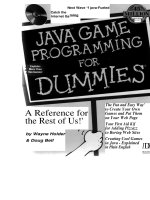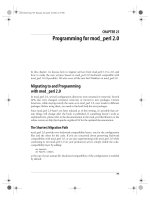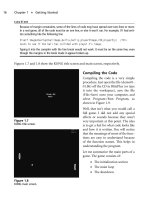Practical mod_perl-CHAPTER 25: Programming for mod_perl 2.0
Bạn đang xem bản rút gọn của tài liệu. Xem và tải ngay bản đầy đủ của tài liệu tại đây (750.82 KB, 42 trang )
This is the Title of the Book, eMatter Edition
Copyright © 2004 O’Reilly & Associates, Inc. All rights reserved.
709
Chapter 25
CHAPTER 25
Programming for mod_perl 2.0
In this chapter, we discuss how to migrate services from mod_perl 1.0 to 2.0, and
how to make the new services based on mod_perl 2.0 backward compatible with
mod_perl 1.0 (if possible). We also cover all the new
Perl*Handlers
in mod_perl 2.0.
Migrating to and Programming
with mod_perl 2.0
In mod_perl 2.0, several configuration directives were renamed or removed. Several
APIs also were changed, renamed, removed, or moved to new packages. Certain
functions, while staying exactly the same as in mod_perl 1.0, now reside in different
packages. Before using them, you need to find and load the new packages.
Since mod_perl 2.0 hasn’t yet been released as of this writing, it’s possible that cer-
tain things will change after the book is published. If something doesn’t work as
explained here, please refer to the documentation in the mod_perl distribution or the
online version at for the updated documentation.
The Shortest Migration Path
mod_perl 2.0 provides two backward-compatibility layers: one for the configuration
files and the other for the code. If you are concerned about preserving backward
compatibility with mod_perl 1.0, or are just experimenting with mod_perl 2.0 while
continuing to run mod_perl 1.0 on your production server, simply enable the code-
compatibility layer by adding:
use Apache2;
use Apache::compat;
at the top of your startup file. Backward compatibility of the configuration is enabled
by default.
,ch25.26428 Page 709 Thursday, November 18, 2004 12:47 PM
This is the Title of the Book, eMatter Edition
Copyright © 2004 O’Reilly & Associates, Inc. All rights reserved.
710
|
Chapter 25: Programming for mod_perl 2.0
Migrating Configuration Files
To migrate the configuration files to mod_perl 2.0 syntax, you may need to make
certain adjustments. Several configuration directives are deprecated in 2.0 but are
still available for backward compatibility with mod_perl 1.0. If you don’t need back-
ward compatibility, consider using the directives that have replaced them.
PerlHandler
PerlHandler
has been replaced with
PerlResponseHandler
.
PerlSendHeader
PerlSendHeader
has been replaced with the
PerlOptions +/-ParseHeaders
directive:
PerlSendHeader On => PerlOptions +ParseHeaders
PerlSendHeader Off => PerlOptions -ParseHeaders
PerlSetupEnv
PerlSetupEnv
has been replaced with the
PerlOptions +/-SetupEnv
directive:
PerlSetupEnv On => PerlOptions +SetupEnv
PerlSetupEnv Off => PerlOptions -SetupEnv
PerlTaintCheck
Taint mode can now be turned on with:
PerlSwitches -T
As with standard Perl, taint mode is disabled by default. Once enabled, taint mode
cannot be turned off.
PerlWarn
Warnings now can be enabled globally with:
PerlSwitches -w
PerlFreshRestart
PerlFreshRestart
is a mod_perl 1.0 legacy option and doesn’t exist in mod_perl 2.0.
A full tear-down and startup of interpreters is done on restart.
If you need to use the same httpd.conf file for 1.0 and 2.0, use:
<IfDefine !MODPERL2>
PerlFreshRestart On
</IfDefine>
,ch25.26428 Page 710 Thursday, November 18, 2004 12:47 PM
This is the Title of the Book, eMatter Edition
Copyright © 2004 O’Reilly & Associates, Inc. All rights reserved.
Migrating to and Programming with mod_perl 2.0
|
711
Code Porting
mod_perl 2.0 is trying hard to be backward compatible with mod_perl 1.0. How-
ever, some things (mostly APIs) have changed. To gain complete compatibility with
1.0 while running under 2.0, you should load the compatibility module as early as
possible:
use Apache::compat;
at server startup. Unless there are forgotten things or bugs, your code should work
without any changes under the 2.0 series.
However, if you don’t have a good reason to keep 1.0 compatibility, you should try
to remove the compatibility layer and adjust your code to work under 2.0 without it.
This will improve performance. The online mod_perl documentation includes a doc-
ument ( that explains what
APIs have changed and what new APIs should be used instead.
If you have mod_perl 1.0 and 2.0 installed on the same system and the two use the
same Perl libraries directory (e.g., /usr/lib/perl5), to use mod_perl 2.0 make sure to
first load the
Apache2
module, which will perform the necessary adjustments to
@INC
:
use Apache2; # if you have 1.0 and 2.0 installed
use Apache::compat;
So if before loading
Apache2.pm
the
@INC
array consisted of:
/usr/lib/perl5/5.8.0/i686-linux-thread-multi
/usr/lib/perl5/5.8.0
/usr/lib/perl5/site_perl/5.8.0/i686-linux-thread-multi
/usr/lib/perl5/site_perl/5.8.0
/usr/lib/perl5/site_perl
.
it will now look like this:
/usr/lib/perl5/site_perl/5.8.0/i686-linux-thread-multi/Apache2
/usr/lib/perl5/5.8.0/i686-linux-thread-multi
/usr/lib/perl5/5.8.0
/usr/lib/perl5/site_perl/5.8.0/i686-linux-thread-multi
/usr/lib/perl5/site_perl/5.8.0
/usr/lib/perl5/site_perl
.
Notice that a new directory was appended to the search path. If, for example, the
code attempts to load
Apache::Server
and there are two versions of this module
under /usr/lib/perl5/site_perl/:
5.8.0/i686-linux-thread-multi/Apache/Server.pm
5.8.0/i686-linux-thread-multi/Apache2/Apache/Server.pm
the mod_perl 2.0 version will be loaded first, because the directory 5.8.0/i686-linux-
thread-multi/Apache2 comes before the directory 5.8.0/i686-linux-thread-multi in
@INC
.
,ch25.26428 Page 711 Thursday, November 18, 2004 12:47 PM
This is the Title of the Book, eMatter Edition
Copyright © 2004 O’Reilly & Associates, Inc. All rights reserved.
712
|
Chapter 25: Programming for mod_perl 2.0
Finally, mod_perl 2.0 has all its methods spread across many modules. To use these
methods, you first have to load the modules containing them. The
ModPerl::
MethodLookup
module can be used to figure out what modules need to be loaded. For
example, if you try to use:
$r->construct_url( );
and mod_perl complains that it can’t find the
construct_url()
method, you can ask
ModPerl::MethodLookup
:
panic% perl -MApache2 -MModPerl::MethodLookup -e print_method construct_url
This will print:
to use method 'construct_url' add:
use Apache::URI ( );
Another useful feature provided by
ModPerl::MethodLookup
is the
preload_all_
modules( )
function, which preloads all mod_perl 2.0 modules. This is useful when
you start to port your mod_perl 1.0 code (though preferrably avoided in the produc-
tion environment to save memory). You can simply add the following snippet to
your startup.pl file:
use ModPerl::MethodLookup;
ModPerl::MethodLookup::preload_all_modules( );
ModPerl::Registry Family
In mod_perl 2.0,
Apache::Registry
and friends (
Apache::PerlRun
,
Apache::
RegistryNG
, etc.) have migrated into the
ModPerl::
namespace. The new family is
based on the idea of
Apache::RegistryNG
from mod_perl 1.0, where you can custom-
ize pretty much all the functionality by providing your own hooks. The functionality
of the
Apache::Registry
,
Apache::RegistryBB
, and
Apache::PerlRun
modules hasn’t
changed from the user’s perspective, except for the namespace. All these modules are
now derived from the
ModPerl::RegistryCooker
class. So if you want to change the
functionality of any of the existing subclasses, or you want to “cook” your own regis-
try module, it can be done easily. Refer to the
ModPerl::RegistryCooker
manpage for
more information.
Here is a typical registry section configuration in mod_perl 2.0:
Alias /perl/ /home/httpd/perl/
<Location /perl>
SetHandler perl-script
PerlResponseHandler ModPerl::Registry
Options +ExecCGI
PerlOptions +ParseHeaders
</Location>
As we explained earlier, the
ParseHeaders
option is needed if the headers are being
sent via
print( )
(i.e., without using the mod_perl API) and comes as a replacement
for the
PerlSendHeader
option in mod_perl 1.0.
,ch25.26428 Page 712 Thursday, November 18, 2004 12:47 PM
This is the Title of the Book, eMatter Edition
Copyright © 2004 O’Reilly & Associates, Inc. All rights reserved.
Migrating to and Programming with mod_perl 2.0
|
713
Example 25-1 shows a simple registry script that prints the environment variables.
Save the file in /home/httpd/perl/print_env.pl and make it executable:
panic% chmod 0700 /home/stas/modperl/mod_perl_rules1.pl
Now issue a request to http://localhost/perl/print_env.pl, and you should see all the
environment variables printed out.
One currently outstanding issue with the registry family is the issue with
chdir( )
.
mod_perl 1.0 registry modules always performed
cdhir( )
s to the directory of the
script, so scripts could require modules relative to the directory of the script. Since
mod_perl 2.0 may run in a threaded environment, the registry scripts can no longer
call
chdir( )
, because when one thread performs a
chdir( )
it affects the whole pro-
cess—all other threads will see that new directory when calling
Cwd::cwd( )
, which
will wreak havoc. As of this writing, the registry modules can’t handle this problem
(they simply don’t
chdir( )
to the script’s directory); however, a satisfying solution
will be provided by the time mod_perl 2.0 is released.
Method Handlers
In mod_perl 1.0, method handlers had to be specified by using the
($$)
prototype:
package Eagle;
@ISA = qw(Bird);
sub handler ($$) {
my($class, $r) = @_;
...;
}
Starting with Perl Version 5.6, you can use subroutine attributes, and that’s what
mod_perl 2.0 does instead of conventional prototypes:
package Eagle;
@ISA = qw(Bird);
sub handler : method {
my($class, $r) = @_;
...;
}
See the attributes manpage.
mod_perl 2.0 doesn’t support the
($$)
prototypes, mainly because several callbacks
in 2.0 have more arguments than
$r
, so the
($$)
prototype doesn’t make sense any
Example 25-1. print_env.pl
print "Content-type: text/plain\n\n";
for (sort keys %ENV){
print "$_ => $ENV{$_}\n";
}
,ch25.26428 Page 713 Thursday, November 18, 2004 12:47 PM
This is the Title of the Book, eMatter Edition
Copyright © 2004 O’Reilly & Associates, Inc. All rights reserved.
714
|
Chapter 25: Programming for mod_perl 2.0
more. Therefore, if you want your code to work with both mod_perl generations,
you should use the subroutine attributes.
Apache::StatINC Replacement
Apache::StatINC
has been replaced by
Apache::Reload
, which works for both mod_
perl generations. To migrate to
Apache::Reload
, simply replace:
PerlInitHandler Apache::StatINC
with:
PerlInitHandler Apache::Reload
Apache::Reload
also provides some extra functionality, covered in the module’s
manpage.
New Apache Phases and Corresponding
Perl*Handlers
Because the majority of the Apache phases supported by mod_perl haven’t changed
since mod_perl 1.0, in this chapter we will discuss only those phases and corre-
sponding handlers that were added or changed in mod_perl 2.0.
Figure 25-1 depicts the Apache 2.0 server cycle. You can see the mod_perl phases
PerlOpenLogsHandler
,
PerlPostConfigHandler
, and
PerlChildInitHandler
, which we
will discuss shortly. Later, we will zoom into the connection cycle depicted in
Figure 25-2, which will expose other mod_perl handlers.
Apache 2.0 starts by parsing the configuration file. After the configuration file is
parsed, any
PerlOpenLogsHandler
handlers are executed. After that, any
PerlPostConfigHandler
handlers are run. When the post_config phase is finished the
server immediately restarts, to make sure that it can survive graceful restarts after
starting to serve the clients.
When the restart is completed, Apache 2.0 spawns the workers that will do the
actual work. Depending on the MPM used, these can be threads, processes, or a mix-
ture of both. For example, the worker MPM spawns a number of processes, each
running a number of threads. When each child process is started
PerlChildInitHandler
s are executed. Notice that they are run for each starting pro-
cess, not thread.
From that moment on each working process (or thread) processes connections until
it’s killed by the server or the server is shut down. When the server is shut down, any
registered
PerlChildExitHandler
s are executed.
Example 25-2 demonstrates all the startup phases.
,ch25.26428 Page 714 Thursday, November 18, 2004 12:47 PM
This is the Title of the Book, eMatter Edition
Copyright © 2004 O’Reilly & Associates, Inc. All rights reserved.
New Apache Phases and Corresponding Perl*Handlers
|
715
Figure 25-1. Apache 2.0 server lifecycle
Example 25-2. Book/StartupLog.pm
package Book::StartupLog;
use strict;
use warnings;
use Apache::Log ( );
use Apache::ServerUtil ( );
use File::Spec::Functions;
use Apache::Const -compile => 'OK';
my $log_file = catfile "logs", "startup_log";
my $log_fh;
sub open_logs {
my($conf_pool, $log_pool, $temp_pool, $s) = @_;
my $log_path = Apache::server_root_relative($conf_pool, $log_file);
$s->warn("opening the log file: $log_path");
open $log_fh, ">>$log_path" or die "can't open $log_path: $!";
my $oldfh = select($log_fh); $| = 1; select($oldfh);
say("process $$ is born to reproduce");
return Apache::OK;
}
sub post_config {
my($conf_pool, $log_pool, $temp_pool, $s) = @_;
Connection
Loop
Connection
Loop
Restart
StartUp
and
Config
. . .
PostConfig
Connection
Loop
Server shutdown (+ChildExit)
Create processes/threads (+ChildInit)
OpenLogs
,ch25.26428 Page 715 Thursday, November 18, 2004 12:47 PM
This is the Title of the Book, eMatter Edition
Copyright © 2004 O’Reilly & Associates, Inc. All rights reserved.
716
|
Chapter 25: Programming for mod_perl 2.0
Here’s the httpd.conf configuration section:
PerlModule Book::StartupLog
PerlOpenLogsHandler Book::StartupLog::open_logs
PerlPostConfigHandler Book::StartupLog::post_config
PerlChildInitHandler Book::StartupLog::child_init
PerlChildExitHandler Book::StartupLog::child_exit
When we perform a server startup followed by a shutdown, the logs/startup_log is
created, if it didn’t exist already (it shares the same directory with error_log and
other standard log files), and each stage appends to it its log information. So when
we perform:
panic% bin/apachectl start && bin/apachectl stop
the following is logged to logs/startup_log:
[Thu Mar 6 15:57:08 2003] - open_logs : process 21823 is born to reproduce
[Thu Mar 6 15:57:08 2003] - post_config: configuration is completed
[Thu Mar 6 15:57:09 2003] - END : process 21823 is shutdown
say("configuration is completed");
return Apache::OK;
}
sub child_exit {
my($child_pool, $s) = @_;
say("process $$ now exits");
return Apache::OK;
}
sub child_init {
my($child_pool, $s) = @_;
say("process $$ is born to serve");
return Apache::OK;
}
sub say {
my($caller) = (caller(1))[3] =~ /([^:]+)$/;
if (defined $log_fh) {
printf $log_fh "[%s] - %-11s: %s\n",
scalar(localtime), $caller, $_[0];
}
else {
# when the log file is not open
warn __PACKAGE__ . " says: $_[0]\n";
}
}
END {
say("process $$ is shutdown\n");
}
1;
Example 25-2. Book/StartupLog.pm (continued)
,ch25.26428 Page 716 Thursday, November 18, 2004 12:47 PM
This is the Title of the Book, eMatter Edition
Copyright © 2004 O’Reilly & Associates, Inc. All rights reserved.
New Apache Phases and Corresponding Perl*Handlers
|
717
[Thu Mar 6 15:57:10 2003] - open_logs : process 21825 is born to reproduce
[Thu Mar 6 15:57:10 2003] - post_config: configuration is completed
[Thu Mar 6 15:57:11 2003] - child_init : process 21830 is born to serve
[Thu Mar 6 15:57:11 2003] - child_init : process 21831 is born to serve
[Thu Mar 6 15:57:11 2003] - child_init : process 21832 is born to serve
[Thu Mar 6 15:57:11 2003] - child_init : process 21833 is born to serve
[Thu Mar 6 15:57:12 2003] - child_exit : process 21833 now exits
[Thu Mar 6 15:57:12 2003] - child_exit : process 21832 now exits
[Thu Mar 6 15:57:12 2003] - child_exit : process 21831 now exits
[Thu Mar 6 15:57:12 2003] - child_exit : process 21830 now exits
[Thu Mar 6 15:57:12 2003] - END : process 21825 is shutdown
First, we can clearly see that Apache always restarts itself after the first post_config
phase is over. The logs show that the post_config phase is preceded by the open_logs
phase. Only after Apache has restarted itself and has completed the open_logs and
post_config phases again is the child_init phase run for each child process. In our
example we had the setting
StartServers=4
; therefore, you can see that four child
processes were started.
Finally, you can see that on server shutdown, the child_exit phase is run for each
child process and the
END { }
block is executed by the parent process only.
Apache also specifies the pre_config phase, which is executed before the configura-
tion files are parsed, but this is of no use to mod_perl, because mod_perl is loaded
only during the configuration phase.
Now let’s discuss each of the mentioned startup handlers and their implementation
in the
Book::StartupLog
module in detail.
Server Configuration and Startup Phases
open_logs, configured with
PerlOpenLogsHandler
, and post_config, configured with
PerlPostConfigHandler
, are the two new phases available during server startup.
PerlOpenLogsHandler
The open_logs phase happens just before the post_config phase.
Handlers registered by
PerlOpenLogsHandler
are usually used for opening module-
specific log files (e.g., httpd core and mod_ssl open their log files during this phase).
At this stage the
STDERR
stream is not yet redirected to error_log, and therefore any
messages to that stream will be printed to the console from which the server is start-
ing (if one exists).
The
PerlOpenLogsHandler
directive may appear in the main configuration files and
within
<VirtualHost>
sections.
Apache will continue executing all handlers registered for this phase until the first
handler returns something other than
Apache::OK
or
Apache::DECLINED
.
,ch25.26428 Page 717 Thursday, November 18, 2004 12:47 PM
This is the Title of the Book, eMatter Edition
Copyright © 2004 O’Reilly & Associates, Inc. All rights reserved.
718
|
Chapter 25: Programming for mod_perl 2.0
As we saw in the
Book::StartupLog::open_logs
handler, the open_logs phase han-
dlers accept four arguments: the configuration pool,
*
the logging streams pool, the
temporary pool, and the server object:
sub open_logs {
my($conf_pool, $log_pool, $temp_pool, $s) = @_;
my $log_path = Apache::server_root_relative($conf_pool, $log_file);
$s->warn("opening the log file: $log_path");
open $log_fh, ">>$log_path" or die "can't open $log_path: $!";
my $oldfh = select($log_fh); $| = 1; select($oldfh);
say("process $$ is born to reproduce");
return Apache::OK;
}
In our example the handler uses the
Apache::server_root_relative( )
function to set
the full path to the log file, which is then opened for appending and set to unbuf-
fered mode. Finally, it logs the fact that it’s running in the parent process.
As you’ve seen in this example, this handler is configured by adding the following to
httpd.conf:
PerlOpenLogsHandler Book::StartupLog::open_logs
PerlPostConfigHandler
The post_config phase happens right after Apache has processed the configuration
files, before any child processes are spawned (which happens at the child_init phase).
This phase can be used for initializing things to be shared between all child pro-
cesses. You can do the same in the startup file, but in the post_config phase you have
access to a complete configuration tree.
The post_config phase is very similar to the open_logs phase. The
PerlPostConfigHandler
directive may appear in the main configuration files and
within
<VirtualHost>
sections. Apache will run all registered handlers for this phase
until a handler returns something other than
Apache::OK
or
Apache::DECLINED
. This
phase’s handlers receive the same four arguments as the open_logs phase’s handlers.
From our example:
sub post_config {
my($conf_pool, $log_pool, $temp_pool, $s) = @_;
say("configuration is completed");
return Apache::OK;
}
This example handler just logs that the configuration was completed and returns
right away.
* Pools are used by Apache for memory-handling functions. You can make use of them from the Perl space,
too.
,ch25.26428 Page 718 Thursday, November 18, 2004 12:47 PM
This is the Title of the Book, eMatter Edition
Copyright © 2004 O’Reilly & Associates, Inc. All rights reserved.
New Apache Phases and Corresponding Perl*Handlers
|
719
This handler is configured by adding the following to httpd.conf:
PerlOpenLogsHandler Book::StartupLog::post_config
PerlChildInitHandler
The child_init phase happens immediately after a child process is spawned. Each
child process (not a thread!) will run the hooks of this phase only once in its life-
time.
In the prefork MPM this phase is useful for initializing any data structures that
should be private to each process. For example,
Apache::DBI
preopens database con-
nections during this phase, and
Apache::Resource
sets the process’s resource limits.
The
PerlChildInitHandler
directive should appear in the top-level server configura-
tion file. All
PerlChildInitHandler
s will be executed, disregarding their return values
(although mod_perl expects a return value, so returning
Apache::OK
is a good idea).
In the
Book::StartupLog
example we used the
child_init( )
handler:
sub child_init {
my($child_pool, $s) = @_;
say("process $$ is born to serve");
return Apache::OK;
}
The
child_init( )
handler accepts two arguments: the child process pool and the
server object. The example handler logs the PID of the child process in which it’s run
and returns.
This handler is configured by adding the following to httpd.conf:
PerlOpenLogsHandler Book::StartupLog::child_init
PerlChildExitHandler
The child_exit phase is executed before the child process exits. Notice that it hap-
pens only when the process exits, not when the thread exits (assuming that you are
using a threaded MPM).
The
PerlChildExitHandler
directive should appear in the top-level server configura-
tion file. mod_perl will run all registered
PerlChildExitHandler
handlers for this
phase until a handler returns something other than
Apache::OK
or
Apache::DECLINED
.
In the
Book::StartupLog
example we used the
child_exit( )
handler:
sub child_exit {
my($child_pool, $s) = @_;
say("process $$ now exits");
return Apache::OK;
}
The
child_exit( )
handler accepts two arguments: the child process pool and the
server object. The example handler logs the PID of the child process in which it’s run
and returns.
,ch25.26428 Page 719 Thursday, November 18, 2004 12:47 PM
This is the Title of the Book, eMatter Edition
Copyright © 2004 O’Reilly & Associates, Inc. All rights reserved.
720
|
Chapter 25: Programming for mod_perl 2.0
As you saw in the example, this handler is configured by adding the following to
httpd.conf:
PerlOpenLogsHandler Book::StartupLog::child_exit
Connection Phases
Since Apache 2.0 makes it possible to implement protocols other than HTTP, the
connection phases pre_connection, configured with
PerlPreConnectionHandler
, and
process_connection, configured with
PerlProcessConnectionHandler
, were added. The
pre_connection phase is used for runtime adjustments of things for each connec-
tion—for example, mod_ssl uses the pre_connection phase to add the SSL filters if
SSLEngine On
is configured, regardless of whether the protocol is HTTP, FTP, NNTP,
etc. The process_connection phase is used to implement various protocols, usually
those similar to HTTP. The HTTP protocol itself is handled like any other protocol;
internally it runs the request handlers similar to Apache 1.3.
When a connection is issued by a client, it’s first run through the
PerlPreConnection-
Handler
and then passed to the
PerlProcessConnectionHandler
, which generates the
response. When
PerlProcessConnectionHandler
is reading data from the client, it can
be filtered by connection input filters. The generated response can also be filtered
though connection output filters. Filters are usually used for modifying the data
flowing though them, but they can be used for other purposes as well (e.g., logging
interesting information). Figure 25-2 depicts the connection cycle and the data flow
and highlights which handlers are available to mod_perl 2.0.
Now let’s discuss the
PerlPreConnectionHandler
and
PerlProcessConnectionHandler
handlers in detail.
PerlPreConnectionHandler
The pre_connection phase happens just after the server accepts the connection, but
before it is handed off to a protocol module to be served. It gives modules an oppor-
tunity to modify the connection as soon as possible and insert filters if needed. The
core server uses this phase to set up the connection record based on the type of con-
nection that is being used. mod_perl itself uses this phase to register the connection
input and output filters.
In mod_perl 1.0, during code development
Apache::Reload
was used to automati-
cally reload Perl modules modified since the last request. It was invoked during post_
read_request, the first HTTP request’s phase. In mod_perl 2.0, pre_connection is the
earliest phase, so if we want to make sure that all modified Perl modules are reloaded
for any protocols and their phases, it’s best to set the scope of the Perl interpreter to
the lifetime of the connection via:
PerlInterpScope connection
,ch25.26428 Page 720 Thursday, November 18, 2004 12:47 PM
This is the Title of the Book, eMatter Edition
Copyright © 2004 O’Reilly & Associates, Inc. All rights reserved.
New Apache Phases and Corresponding Perl*Handlers
|
721
and invoke the
Apache::Reload
handler during the pre_connection phase. However,
this development-time advantage can become a disadvantage in production—for
example, if a connection handled by the HTTP protocol is configured as
KeepAlive
and there are several requests coming on the same connection (one handled by mod_
perl and the others by the default image handler), the Perl interpreter won’t be avail-
able to other threads while the images are being served.
Apache will continue executing all handlers registered for this phase until the first
handler returns something other than
Apache::OK
or
Apache::DECLINED
.
The
PerlPreConnectionHandler
directive may appear in the main configuration files
and within
<VirtualHost>
sections.
A pre_connection handler accepts a connection record and a socket object as its argu-
ments:
sub handler {
my ($c, $socket) = @_;
# ...
return Apache::OK;
}
Figure 25-2. Apache 2.0 connection cycle
Client
PreConnection ProcessConnection
Connection
Input
Filters
Connection
Output
Filters
Request Response
,ch25.26428 Page 721 Thursday, November 18, 2004 12:47 PM
This is the Title of the Book, eMatter Edition
Copyright © 2004 O’Reilly & Associates, Inc. All rights reserved.
722
|
Chapter 25: Programming for mod_perl 2.0
PerlProcessConnectionHandler
The process_connection phase is used to process incoming connections. Only proto-
col modules should assign handlers for this phase, as it gives them an opportunity to
replace the standard HTTP processing with processing for some other protocol (e.g.,
POP3, FTP, etc.).
Apache will continue executing all handlers registered for this phase until the first
handler returns something other than
Apache::DECLINED
.
The
PerlProcessConnectionHandler
directive may appear in the main configuration
files and within
<VirtualHost>
sections.
The process_connection handler can be written in two ways. The first way is to
manipulate bucket brigades, in a way very similar to the filters. The second, simpler
way is to bypass all the filters and to read from and write to the connection socket
directly.
A process_connection handler accepts a connection record object as its only argu-
ment:
sub handler {
my ($c) = @_;
# ...
return Apache::OK;
}
Now let’s look at two examples of connection handlers. The first uses the connec-
tion socket to read and write the data, and the second uses bucket brigades to
accomplish the same thing and allow the connection filters to do their work.
Socket-based protocol module.
To demonstrate the workings of a protocol module,
we’ll take a look at the
Book::Eliza
module, which sends the data read from the cli-
ent as input to
Chatbot::Eliza
, which in turn implements a mock Rogerian psycho-
therapist and forwards the response from the psychotherapist back to the client. In
this module we will use the implementation that works directly with the connection
socket and therefore bypasses any connection filters.
A protocol handler is configured using the
PerlProcessConnectionHandler
directive,
and we will use the
Listen
and
<VirtualHost>
directives to bind to the nonstandard
port 8084:
Listen 8084
<VirtualHost _default_:8084>
PerlModule Book::Eliza
PerlProcessConnectionHandler Book::Eliza
</VirtualHost>
Book::Eliza
is then enabled when starting Apache:
panic% httpd
,ch25.26428 Page 722 Thursday, November 18, 2004 12:47 PM
This is the Title of the Book, eMatter Edition
Copyright © 2004 O’Reilly & Associates, Inc. All rights reserved.
New Apache Phases and Corresponding Perl*Handlers
|
723
And we give it a whirl:
panic% telnet localhost 8084
Trying 127.0.0.1...
Connected to localhost (127.0.0.1).
Escape character is '^]'.
Hello Eliza
How do you do. Please state your problem.
How are you?
Oh, I?
Why do I have core dumped?
You say Why do you have core dumped?
I feel like writing some tests today, you?
I'm not sure I understand you fully.
Good bye, Eliza
Does talking about this bother you?
Connection closed by foreign host.
The code is shown in Example 25-3.
Example 25-3. Book/Eliza.pm
package Book::Eliza;
use strict;
use warnings FATAL => 'all';
use Apache::Connection ( );
use APR::Socket ( );
require Chatbot::Eliza;
use Apache::Const -compile => 'OK';
use constant BUFF_LEN => 1024;
my $eliza = new Chatbot::Eliza;
sub handler {
my $c = shift;
my $socket = $c->client_socket;
my $buff;
my $last = 0;
while (1) {
my($rlen, $wlen);
$rlen = BUFF_LEN;
$socket->recv($buff, $rlen);
last if $rlen <= 0;
,ch25.26428 Page 723 Thursday, November 18, 2004 12:47 PM
This is the Title of the Book, eMatter Edition
Copyright © 2004 O’Reilly & Associates, Inc. All rights reserved.
724
|
Chapter 25: Programming for mod_perl 2.0
The example handler starts with the standard package declaration and, of course,
use
strict;
. As with all
Perl*Handler
s, the subroutine name defaults to
handler
. How-
ever, in the case of a protocol handler, the first argument is not a
request_rec
, but a
conn_rec
blessed into the
Apache::Connection
class. We have direct access to the cli-
ent socket via
Apache::Connection
’s
client_socket()
method, which returns an
object blessed into the
APR::Socket
class.
Inside the read/send loop, the handler attempts to read
BUFF_LEN
bytes from the cli-
ent socket into the
$buff
buffer. The
$rlen
parameter will be set to the number of
bytes actually read. The
APR::Socket::recv( )
method returns an APR status value,
but we need only check the read length to break out of the loop if it is less than or
equal to 0 bytes. The handler also breaks the loop after processing an input includ-
ing the “good bye” string.
Otherwise, if the handler receives some data, it sends this data to the
$eliza
object
(which represents the psychotherapist), whose returned text is then sent back to the
client with the
APR::Socket::send( )
method. When the read/print loop is finished
the handler returns
Apache::OK
, telling Apache to terminate the connection. As men-
tioned earlier, since this handler is working directly with the connection socket, no
filters can be applied.
Bucket brigade–based protocol module.
Now let’s look at the same module, but this time
implemented by manipulating bucket brigades. It runs its output through a connec-
tion output filter that turns all uppercase characters into their lowercase equivalents.
The following configuration defines a
<VirtualHost>
listening on port 8085 that
enables the
Book::Eliza2
connection handler, which will run its output through the
Book::Eliza2::lowercase_filter
filter:
Listen 8085
<VirtualHost _default_:8085>
PerlModule Book::Eliza2
PerlProcessConnectionHandler Book::Eliza2
PerlOutputFilterHandler Book::Eliza2::lowercase_filter
</VirtualHost>
# \r is sent instead of \n if the client is talking over telnet
$buff =~ s/[\r\n]*$//;
$last++ if $buff =~ /good bye/i;
$buff = $eliza->transform( $buff ) . "\n\n";
$socket->send($buff, length $buff);
last if $last;
}
Apache::OK;
}
1;
Example 25-3. Book/Eliza.pm (continued)
,ch25.26428 Page 724 Thursday, November 18, 2004 12:47 PM









